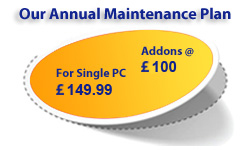Call 0800 031 4181
Windows Vista Slow
- Too many programs auto-loading at startup.
- Unnecessary application and program clutter.
- Malicious browser plugins and toolbars.
- High-level of disk fragmentation.
- Antivirus scan scheduled at startup.
- Possible malware or virus infection.
- Click Start, type Msconfig, and press ENTER. Msconfig is a Control Panel applet that gives your Windows System Configuration.
- Once the program is up, click the Startup tab. This will show all the programs that Windows launches during the boot process.
- If this is a long list, this could be a source of your problem. Deselect ones that you don't need. You should limit this list to include no more than 4 or 5 programs.
- Note you can always start the programs that you have deselected in Startup Tab by simply clicking on the Shortcut Icon on your desktop. So these programs are always available to you.
- Most users overtime end up with programs and applications that they seldom use. Today on the net there are thousands of free applications that are just a click away.
- Dormant, seldom used programs, take unnecessary storage space, fragment your disk, and even bloat Windows Registry making it slow to read and write for active programs.
- Free utility programs like tune-up programs or spyware checkers, virus scanners, disk cleaners, and backup tools often run automatically at startup, quietly chugging along in the background. Many people have no idea they're even running.
- To remove these unused dormant programs, got to Windows Control Panel and select the Install/Uninstall Program applet; Select the programs that don't look familiar or ones you have not used and uninstall them.
- If this does not fix the performance issue go to Step 3.
- Fragmentation makes your hard disk do extra work that can slow down your computer.
- To defragment your hard disk, Open Disk Defragmenter applet in the Control Panel.
- Before you decide to defragment the disk, determine if the disk needs to be defragmented or not. Click Analyze disk.
- Once Windows is finished analyzing the disk, you can check the percentage of fragmentation on the disk in the Last Run column. If the number is above 10%, you should defragment the disk.
- Click Defragment disk. Disk Defragmenter might take from several minutes to a few hours to finish, depending on the size and degree of fragmentation.
- Start the browser you use for surfing the net.
- Depending on your browser, do one of the following.
- For Internet Explorer: On the Tools menu, click Manage Add-ons.
- For Mozilla Firefox: On the top-right corner, click the Open menu icon, and click Add-ons. In the Add-ons Manager page, select Extensions.
- For Google Chrome: On the top-right corner, click the Customize and control Google Chrome icon, and click Settings. Under Chrome, click Extensions.
- Select the add-ons one at a time and disable them.
- If the browser is fast, the problem is with one of the toolbars. Enable the browser plug-in one at a time to find the malicious one, and keep it disabled.
- If this does not fix the performance issue go to Step 2.




 I was working with computer technician Atish Patil, the overall experience was good and informative...
I was working with computer technician Atish Patil, the overall experience was good and informative... 

















